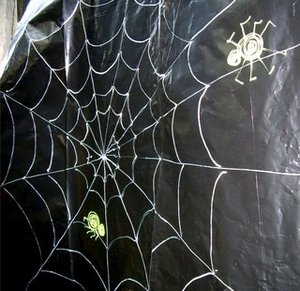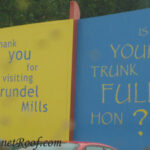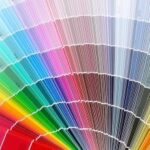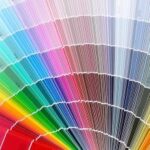Haunted Houses are wildly popular, and a terrific addition to your neighborhood Halloween Trick or Treat festivities. Building your own haunted house doesn’t have to be expensive, and requires little more than a few props, yards of black visqueen, paint and some imagination.
Creating the structure
Garages are terrific places to set up a haunted house, although a covered patio or car port will also work. Begin by covering the walls with black visqueen, or in the case of a carport, creating walls. Don’t bother stapling the visqueen directly to the walls; hanging it from the ceiling is preferable since swinging sheets of black plastic add to the spookiness.
Once the exterior framework of the haunted house is in place, create a maze by hanging even more sheets of visqueen from the ceiling. The maze doesn’t have to be too elaborate ~ a simple passage way in the shape of a couple of Esses will do. By creating passageways, neighborhood Trick or Treater’s will be forced down a gauntlet of spooky activities.
Building tableaus
After the walls are up, the fun part of decorating can begin. At the opening of the Haunted House, string up cobwebs and lots of spiders. If you are skilled with paint, sketch in glow-in-the-dark cobwebs on the visqueen walls. Those cobwebs are what the kids should see when they look inside the Haunted House ~ giving them no clue as to what hides behind the corner.
And once they turn that first corner, you’ll have them walking straight into their first spooky tableau! This is the place for a cemetery, which can be crafted from cardboard headstones decorated with glow in the dark paint. Draw a luminescent skeleton on the visqueen wall, toss a few luminescent bones around, and set up a fog machine if one is available.
As the kids leave the cemetery and turn down the halls, they will enter another passageway which should be scattered with a few spooky props. These props should be tied into the second tableau hidden behind the next corner.
This second tableau is a great place to stage a costumed character such as a headless knight or the Headless Horseman. Props leading up to the knight could include some bloodied swords; for the Headless Horseman, the passage should be lined with glowing pumpkins. And how should the costumed character act? From our experience, kids under the age of 8 are scared enough walking through the haunted house without someone yelling “Boo!” at them. For youngsters, have the costumed character stand quietly and even just wave. For older kids however, the character can hide in the shadows to jump out and howl when the Trick or Treaters least expect it.
A final tableau could be set up as Dr. Frankenstein’s laboratory. The last tableau should be placed by the exit door, and would be the last stop before passing out the candy. Set up a table with cauldrons or buckets, test tubes, and fake body parts ~ and invite the kids to reach into the cauldrons to “find” their treats. The cauldrons can be filled with cold, wet spaghetti which is a bit of an unsettling sensation in the dark! For adding spookiness, bury some creepy body parts in the bottom of the cauldron ~ peeled grapes work for eyes, and papayas can be cut into the shape of the heart or other organs. Place your Halloween candy in a bucket without spaghetti since the moisture will ruin the candy.
If you have the funds, additional Halloween props can be tucked in the different corners of your haunted house. I preferred using cobwebs since they are so inexpensive and can be strategically placed to brush against faces in the dark.
Creating a Haunted House doesn’t have to be expensive; the real trick is to darken the environment, and disorient the kids as they navigate around the garage. Not knowing where they are or what will pop out of the dark to scare them, is half the fun of visiting a Haunted House.




